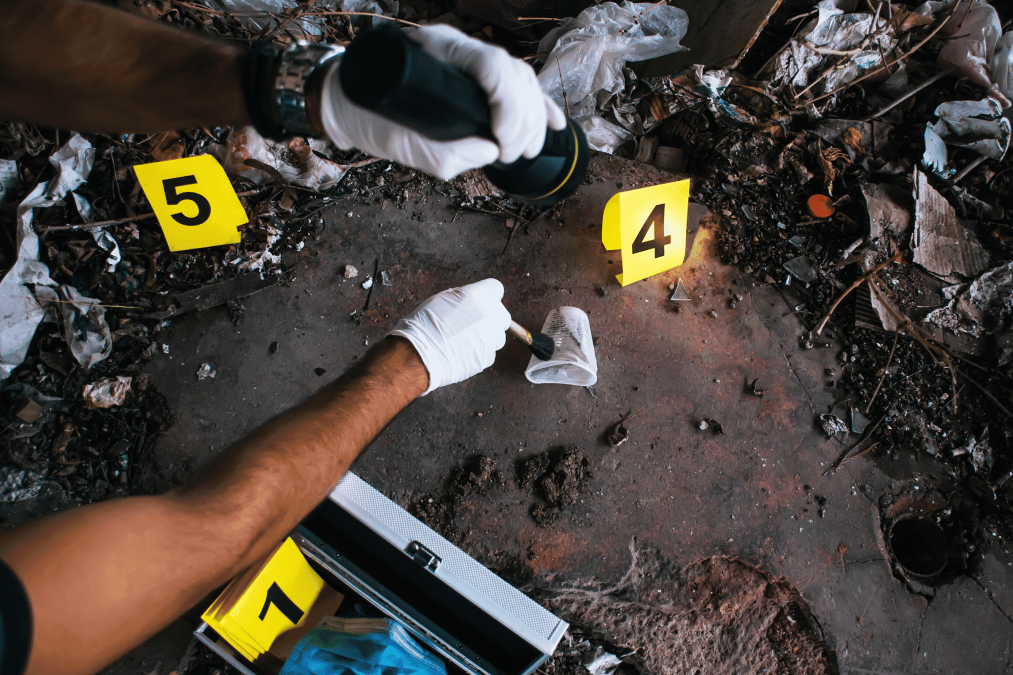
Menu

Services


Fire is a complex chemical process, and fire investigators must understand the basic chemistry and physics.
Fire occurs due to the exothermic reaction of combustion (burning), producing heat and light. In order for a fire to occur, three vital components must be present: a fuel source, an oxidant (O2) and a sufficient amount of energy in the form of heat. Together these make up the fire triangle. A fourth factor can also be described – a self-sustaining chemical chain reaction – to produce the fire tetrahedron. The absence of any of these conditions will result in a fire not starting or extinguishing through smothering (oxygen removal), cooling (heat removal) or starving (fuel removal). Solid and liquid materials do not actually combust, but the process of heating causes them to produce vapours which can burn. This is the process of pyrolysis. Through this pyrolysis products will be formed, flammable and volatile substances of low molecular weight caused through the decomposition of materials by fire. Heat produced by a fire can spread in one of three ways; convection, conduction and radiation. Convection is the transfer of heat through air circulation, and only occurs in liquids and gases. An example of convection is the heat from a fire rising and heating the ceiling of a room.
Matches or lighters can be a primary igniter, along with the associated smoking materials. However, many small appliances, chemicals, and other heat-producing items can be and are a source of heat for uncontrolled fires. The first material ignited has a form or shape, and this too is important. Everything has its own burning characteristics that need to be examined. Ignition will occur when all required conditions to start a fire occur, producing either a smoldering or flaming fire. This will often be induced by the addition of heat to a fuel in air, which can be caused by various sources such as exothermic chemical reactions, friction, solar radiation and electricity.
The temperature required for ignition to occur varies depending on the fuel. The flash point is the minimum temperature at which fuel favor is momentarily ignited in air by an external ignition source. However this will not necessarily sustain combustion and produce a fire. The flame or fire point is the minimum temperature at which enough vapour is produced to allow continued combustion. This is usually a few degrees higher than the flash point. Both the flash and flame point of a substance can be determined by placing a small amount of sample in an airtight container, gradually increasing its temperature whilst periodically adding an ignition source, and then measuring the point at which the flash and flame point is reached. The flash point, flame point and spontaneous ignition temperature are the lowest temperatures at which a material has ignited when heated experimentally, though these actual temperatures can vary and so should only be used as a guideline. Different fuels also have individual lower and upper flammability limits, the lowest and highest concentrations of flammable gas required for combustion.
At Clue4 Evidence Forensic Lab our experts establish the cause of fire and its direction that is essential for determining how a fire started and how it spread. Cause of fire helps to establish how and why a fire started. Understanding the direction of fire spread is crucial for reconstructing the sequence of events during a fire incident.
Each type of fire has unique causes and implications for safety and legal accountability. By conducting thorough investigations, our experts from Clue4 Evidence Forensic Lab our experts can identify the causes of fires, implement safety measures, and hold responsible parties accountable.
The collection and examination of evidence in fire investigation are essential for understanding the causes and dynamics of fires. From Clue4 Evidence Forensic Lab our experts systematically assess the scene, identify and preserve the evidence, and conduct thorough analyses, they can draw meaningful conclusions about the incident.
The examination of evidence in fire investigations is essential for understanding the causes and dynamics of fires. From Clue4 Evidence Forensic Lab our experts systematically assess the scene, identify and preserve the evidence, and conduct thorough analyses, they can draw meaningful conclusions about the incident.
About
Academy
Services
Non Profit
Blog
Contact
Questioned Documents
Fingerprint Examination
Digital Forensics
Crime Scene Investigation
Forensic Physics
Forensic Psychology
Business Intelligence
Fraud Investigation
Forensic Auditing
Institute of Investigation Sciences
Institute of Legal Studies
Institute of Behavioural Sciences
Institute of Media
Institute of Creative Arts
Questioned Documents Examination
Fingerprint Examination
Lie Detection
Digital Forensics
Cyber Crime Investigation
DNA Analysis
Accident Forensics
Fire Investigation
Serious Fraud Investigation
PCC
Forensic Auditing
Copyright © 2024. Clue4 Evidence
Designed by Taarruni
The Entrance Test is Chargeable. To take Entrance Test, please make payment of Rs. 850 and fill in the below form along with the proof of payment (transaction ID)